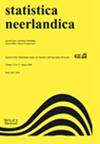Franklin's Randomized Response Model With Correlated Scrambled Variables
IF 0.8
3区 数学
Q2 STATISTICS & PROBABILITY
引用次数: 0
Abstract
We propose two types of estimators that are analogous to Franklin's model. One estimator is derived by concentrating on the row averages of the responses, and another is obtained by concentrating on the column averages of the observed responses. In the latter case we have two responses per respondent from a bi‐variate normal distribution. The proposed estimator based on row averages, by making use of negatively correlated random numbers from a multivariate density, is always more efficient than the corresponding Franklin's estimator. In the case of the proposed estimator based on column averages, we found that the use of positively correlated random numbers from a bivariate density can lead to the most efficient estimator. We also discuss results which are observed by making use of three responses per respondent. When the three responses are recorded, three independent normal densities are derived from three correlated variables. The findings are supported based on analytical, numerical and simulation studies. A simulation study was done to determine the minimum sample size required to produce non‐negative estimates of the population proportion of a sensitive characteristic, and to investigate the 95% nominal coverage by the interval estimates. Ultimately at the end, one best estimator is suggested. A very neat and clean derivations of theoretical results and discussion of numerical and simulation studies are documented in online supplementary material.This article is protected by copyright. All rights reserved.富兰克林的随机反应模型与相关的混乱变量
我们提出了两种类似于富兰克林模型的估计器。一个估计量是通过集中于响应的行平均值得到的,另一个估计量是通过集中于观察到的响应的列平均值得到的。在后一种情况下,我们从双变量正态分布中得到每个应答者的两个回答。所提出的基于行平均值的估计器,通过利用来自多元密度的负相关随机数,总是比相应的富兰克林估计器更有效。在基于列平均值的估计器的情况下,我们发现使用来自二元密度的正相关随机数可以产生最有效的估计器。我们还讨论了通过使用每个受访者的三个回答来观察到的结果。当记录三个响应时,三个独立的正态密度由三个相关变量导出。这些发现得到了分析、数值和模拟研究的支持。进行了模拟研究,以确定产生敏感特征总体比例的非负估计所需的最小样本量,并通过区间估计调查95%的名义覆盖率。最后,给出了一个最好的估计器。一个非常整洁和干净的推导理论结果和讨论的数值和模拟研究记录在网上补充材料。这篇文章受版权保护。版权所有。
本文章由计算机程序翻译,如有差异,请以英文原文为准。
求助全文
约1分钟内获得全文
求助全文
来源期刊

Statistica Neerlandica
数学-统计学与概率论
CiteScore
2.60
自引率
6.70%
发文量
26
审稿时长
>12 weeks
期刊介绍:
Statistica Neerlandica has been the journal of the Netherlands Society for Statistics and Operations Research since 1946. It covers all areas of statistics, from theoretical to applied, with a special emphasis on mathematical statistics, statistics for the behavioural sciences and biostatistics. This wide scope is reflected by the expertise of the journal’s editors representing these areas. The diverse editorial board is committed to a fast and fair reviewing process, and will judge submissions on quality, correctness, relevance and originality. Statistica Neerlandica encourages transparency and reproducibility, and offers online resources to make data, code, simulation results and other additional materials publicly available.
 求助内容:
求助内容: 应助结果提醒方式:
应助结果提醒方式:


